Healthcare Management Report: Evaluating Rel8 at Anglicare
VerifiedAdded on 2020/03/04
|40
|9317
|64
Report
AI Summary
This healthcare management report evaluates the impact of the relationship-based practice (Rel8) on Anglicare Southern Queensland (ASQ). It outlines the project's objectives, which include developing an evaluation strategy to measure Rel8's effectiveness in improving service quality and client satisfaction. The report details the project's methodology, including SMART objectives, stakeholder management, and communication processes. It also includes a literature review, identifies key stakeholders, and analyzes their roles. The report provides recommendations for future research and concludes with an assessment of Rel8's impact on ASQ, emphasizing the importance of relationship-based practices in healthcare settings. The report also delves into proactive decision making and reflective practices to strengthen the project.
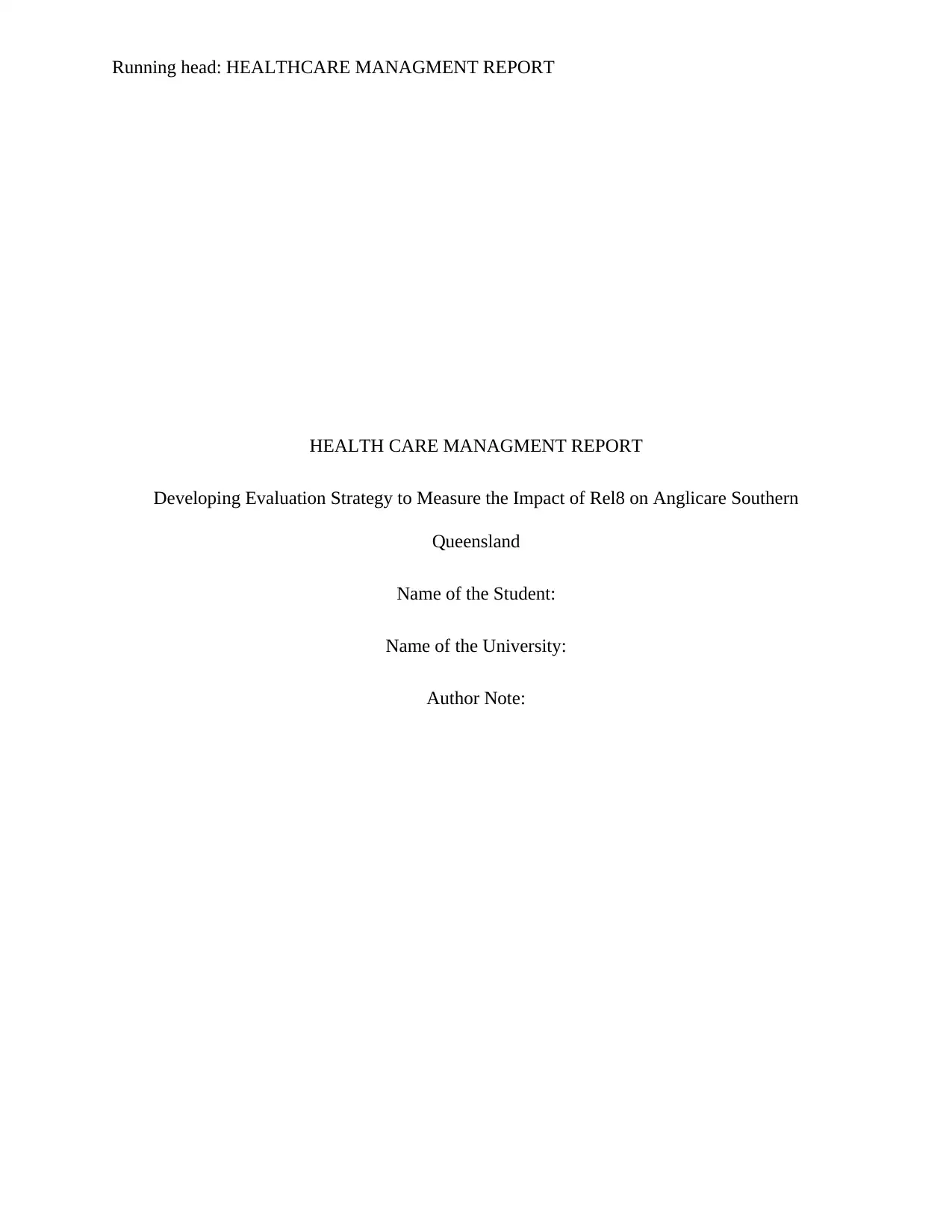
Running head: HEALTHCARE MANAGMENT REPORT
HEALTH CARE MANAGMENT REPORT
Developing Evaluation Strategy to Measure the Impact of Rel8 on Anglicare Southern
Queensland
Name of the Student:
Name of the University:
Author Note:
HEALTH CARE MANAGMENT REPORT
Developing Evaluation Strategy to Measure the Impact of Rel8 on Anglicare Southern
Queensland
Name of the Student:
Name of the University:
Author Note:
Paraphrase This Document
Need a fresh take? Get an instant paraphrase of this document with our AI Paraphraser
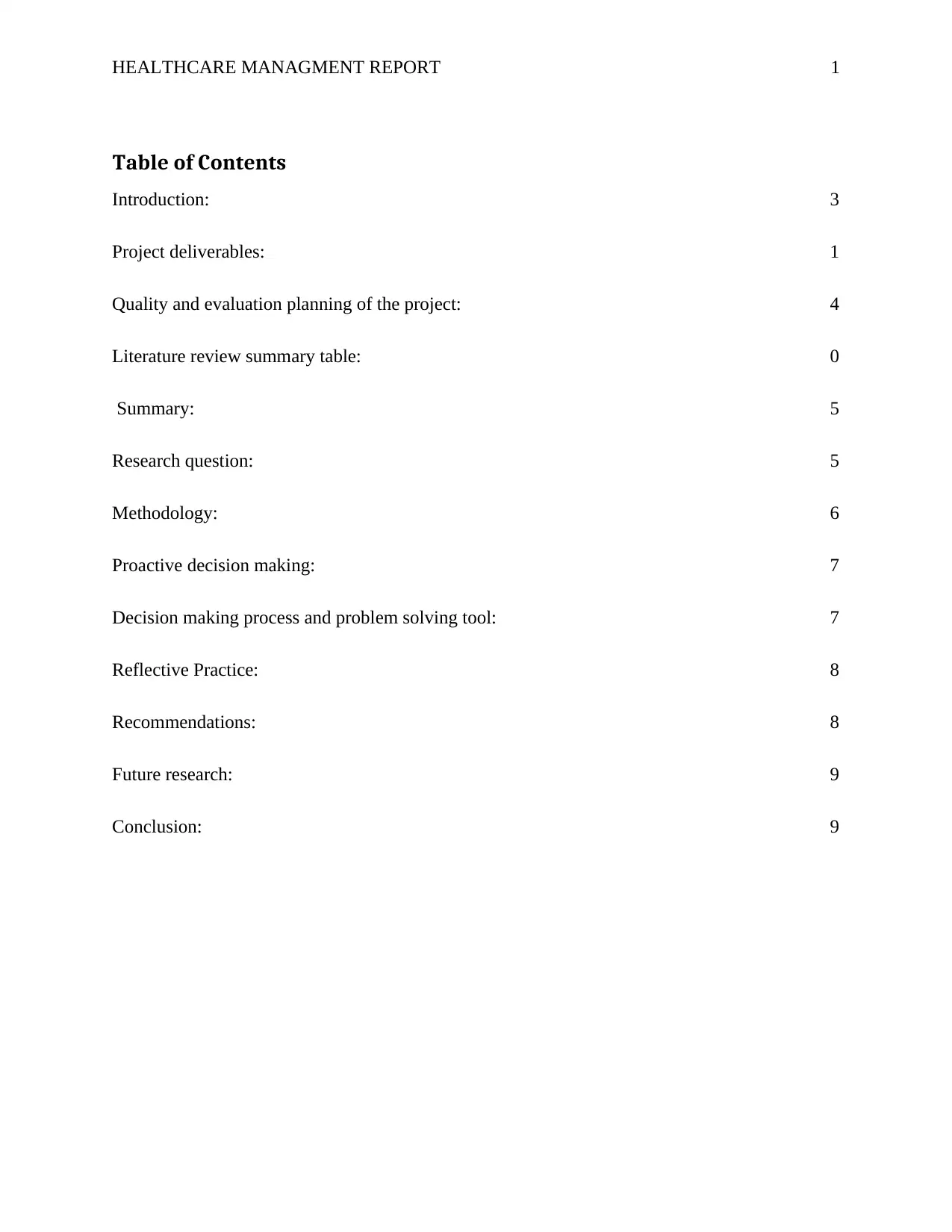
HEALTHCARE MANAGMENT REPORT 1
Table of Contents
Introduction: 3
Project deliverables: 1
Quality and evaluation planning of the project: 4
Literature review summary table: 0
Summary: 5
Research question: 5
Methodology: 6
Proactive decision making: 7
Decision making process and problem solving tool: 7
Reflective Practice: 8
Recommendations: 8
Future research: 9
Conclusion: 9
Table of Contents
Introduction: 3
Project deliverables: 1
Quality and evaluation planning of the project: 4
Literature review summary table: 0
Summary: 5
Research question: 5
Methodology: 6
Proactive decision making: 7
Decision making process and problem solving tool: 7
Reflective Practice: 8
Recommendations: 8
Future research: 9
Conclusion: 9
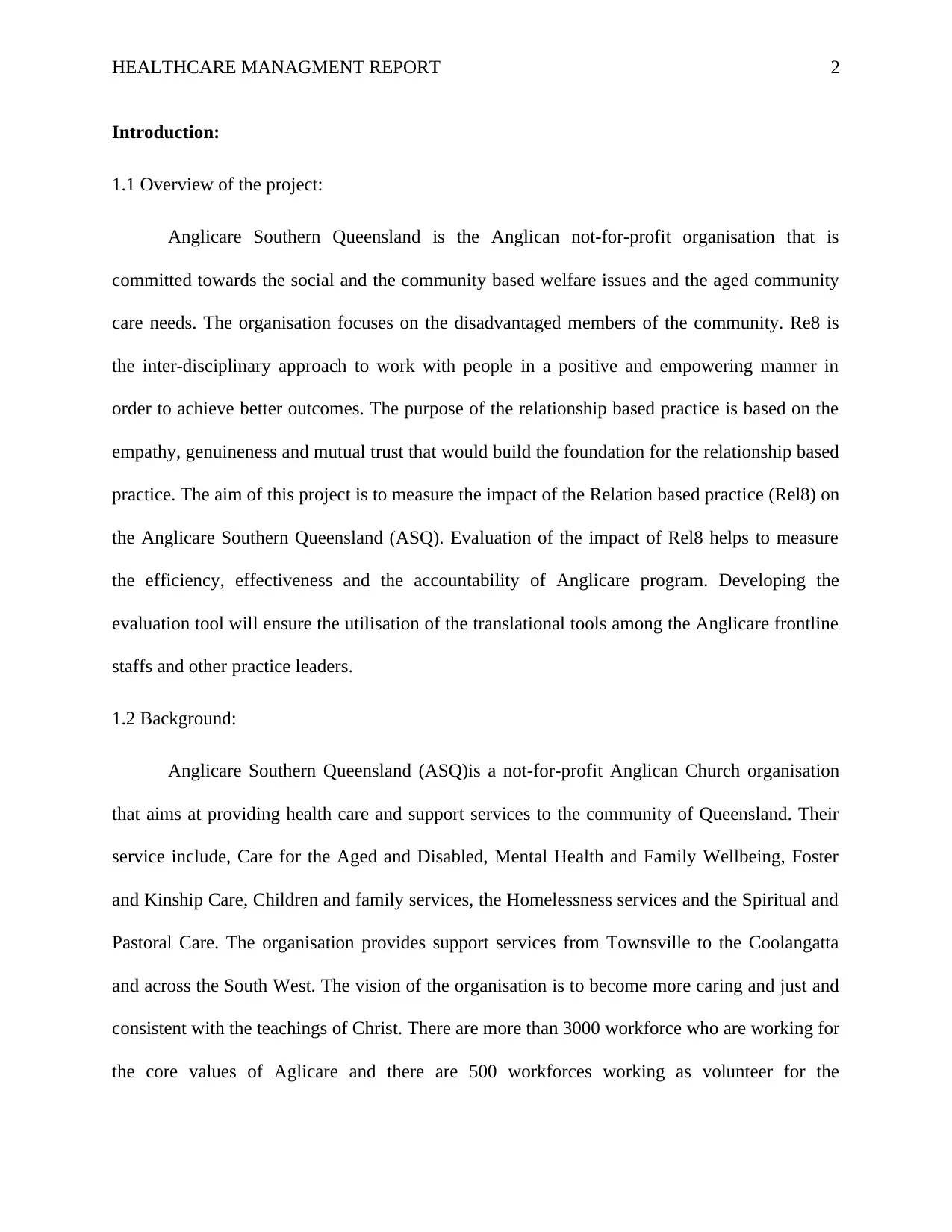
HEALTHCARE MANAGMENT REPORT 2
Introduction:
1.1 Overview of the project:
Anglicare Southern Queensland is the Anglican not-for-profit organisation that is
committed towards the social and the community based welfare issues and the aged community
care needs. The organisation focuses on the disadvantaged members of the community. Re8 is
the inter-disciplinary approach to work with people in a positive and empowering manner in
order to achieve better outcomes. The purpose of the relationship based practice is based on the
empathy, genuineness and mutual trust that would build the foundation for the relationship based
practice. The aim of this project is to measure the impact of the Relation based practice (Rel8) on
the Anglicare Southern Queensland (ASQ). Evaluation of the impact of Rel8 helps to measure
the efficiency, effectiveness and the accountability of Anglicare program. Developing the
evaluation tool will ensure the utilisation of the translational tools among the Anglicare frontline
staffs and other practice leaders.
1.2 Background:
Anglicare Southern Queensland (ASQ)is a not-for-profit Anglican Church organisation
that aims at providing health care and support services to the community of Queensland. Their
service include, Care for the Aged and Disabled, Mental Health and Family Wellbeing, Foster
and Kinship Care, Children and family services, the Homelessness services and the Spiritual and
Pastoral Care. The organisation provides support services from Townsville to the Coolangatta
and across the South West. The vision of the organisation is to become more caring and just and
consistent with the teachings of Christ. There are more than 3000 workforce who are working for
the core values of Aglicare and there are 500 workforces working as volunteer for the
Introduction:
1.1 Overview of the project:
Anglicare Southern Queensland is the Anglican not-for-profit organisation that is
committed towards the social and the community based welfare issues and the aged community
care needs. The organisation focuses on the disadvantaged members of the community. Re8 is
the inter-disciplinary approach to work with people in a positive and empowering manner in
order to achieve better outcomes. The purpose of the relationship based practice is based on the
empathy, genuineness and mutual trust that would build the foundation for the relationship based
practice. The aim of this project is to measure the impact of the Relation based practice (Rel8) on
the Anglicare Southern Queensland (ASQ). Evaluation of the impact of Rel8 helps to measure
the efficiency, effectiveness and the accountability of Anglicare program. Developing the
evaluation tool will ensure the utilisation of the translational tools among the Anglicare frontline
staffs and other practice leaders.
1.2 Background:
Anglicare Southern Queensland (ASQ)is a not-for-profit Anglican Church organisation
that aims at providing health care and support services to the community of Queensland. Their
service include, Care for the Aged and Disabled, Mental Health and Family Wellbeing, Foster
and Kinship Care, Children and family services, the Homelessness services and the Spiritual and
Pastoral Care. The organisation provides support services from Townsville to the Coolangatta
and across the South West. The vision of the organisation is to become more caring and just and
consistent with the teachings of Christ. There are more than 3000 workforce who are working for
the core values of Aglicare and there are 500 workforces working as volunteer for the
⊘ This is a preview!⊘
Do you want full access?
Subscribe today to unlock all pages.

Trusted by 1+ million students worldwide
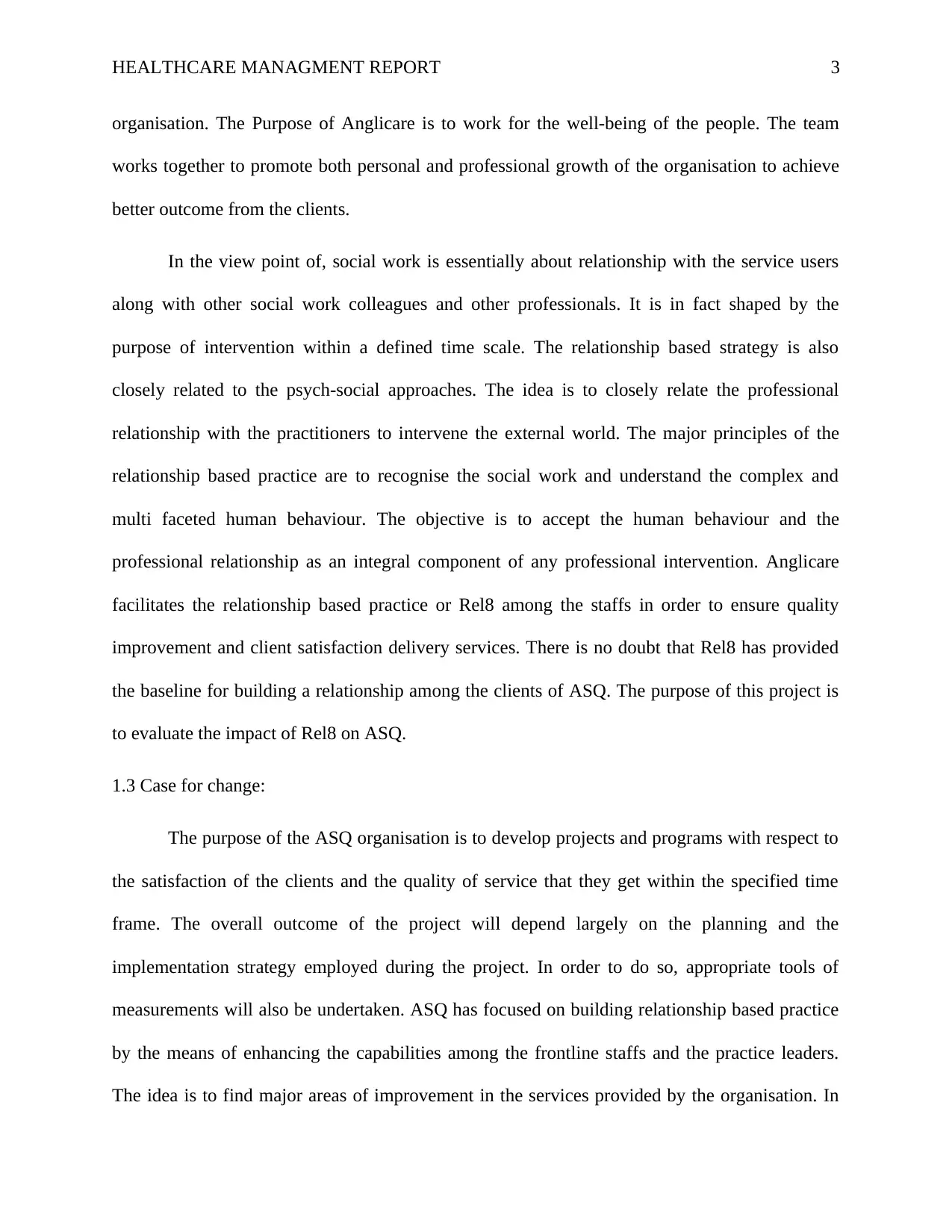
HEALTHCARE MANAGMENT REPORT 3
organisation. The Purpose of Anglicare is to work for the well-being of the people. The team
works together to promote both personal and professional growth of the organisation to achieve
better outcome from the clients.
In the view point of, social work is essentially about relationship with the service users
along with other social work colleagues and other professionals. It is in fact shaped by the
purpose of intervention within a defined time scale. The relationship based strategy is also
closely related to the psych-social approaches. The idea is to closely relate the professional
relationship with the practitioners to intervene the external world. The major principles of the
relationship based practice are to recognise the social work and understand the complex and
multi faceted human behaviour. The objective is to accept the human behaviour and the
professional relationship as an integral component of any professional intervention. Anglicare
facilitates the relationship based practice or Rel8 among the staffs in order to ensure quality
improvement and client satisfaction delivery services. There is no doubt that Rel8 has provided
the baseline for building a relationship among the clients of ASQ. The purpose of this project is
to evaluate the impact of Rel8 on ASQ.
1.3 Case for change:
The purpose of the ASQ organisation is to develop projects and programs with respect to
the satisfaction of the clients and the quality of service that they get within the specified time
frame. The overall outcome of the project will depend largely on the planning and the
implementation strategy employed during the project. In order to do so, appropriate tools of
measurements will also be undertaken. ASQ has focused on building relationship based practice
by the means of enhancing the capabilities among the frontline staffs and the practice leaders.
The idea is to find major areas of improvement in the services provided by the organisation. In
organisation. The Purpose of Anglicare is to work for the well-being of the people. The team
works together to promote both personal and professional growth of the organisation to achieve
better outcome from the clients.
In the view point of, social work is essentially about relationship with the service users
along with other social work colleagues and other professionals. It is in fact shaped by the
purpose of intervention within a defined time scale. The relationship based strategy is also
closely related to the psych-social approaches. The idea is to closely relate the professional
relationship with the practitioners to intervene the external world. The major principles of the
relationship based practice are to recognise the social work and understand the complex and
multi faceted human behaviour. The objective is to accept the human behaviour and the
professional relationship as an integral component of any professional intervention. Anglicare
facilitates the relationship based practice or Rel8 among the staffs in order to ensure quality
improvement and client satisfaction delivery services. There is no doubt that Rel8 has provided
the baseline for building a relationship among the clients of ASQ. The purpose of this project is
to evaluate the impact of Rel8 on ASQ.
1.3 Case for change:
The purpose of the ASQ organisation is to develop projects and programs with respect to
the satisfaction of the clients and the quality of service that they get within the specified time
frame. The overall outcome of the project will depend largely on the planning and the
implementation strategy employed during the project. In order to do so, appropriate tools of
measurements will also be undertaken. ASQ has focused on building relationship based practice
by the means of enhancing the capabilities among the frontline staffs and the practice leaders.
The idea is to find major areas of improvement in the services provided by the organisation. In
Paraphrase This Document
Need a fresh take? Get an instant paraphrase of this document with our AI Paraphraser
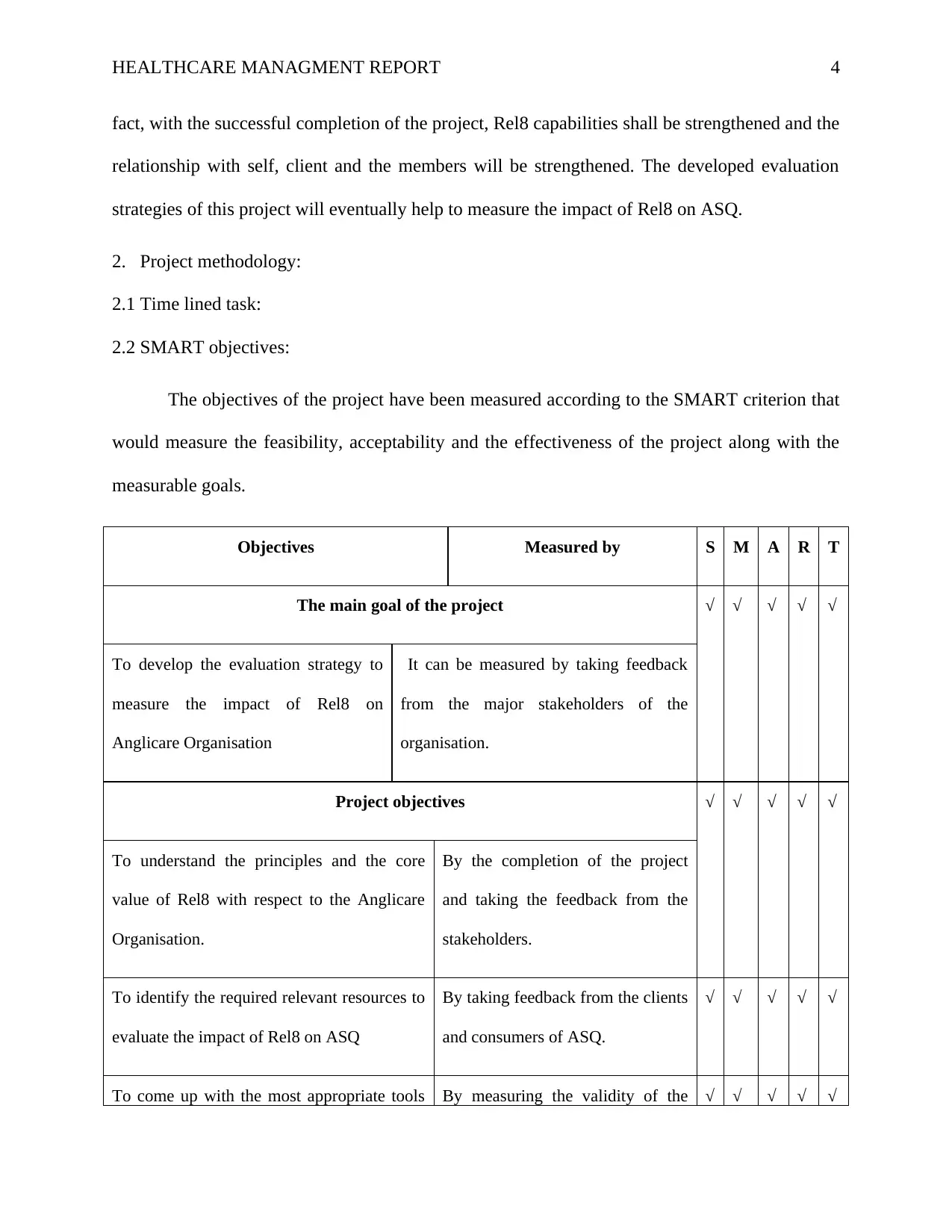
HEALTHCARE MANAGMENT REPORT 4
fact, with the successful completion of the project, Rel8 capabilities shall be strengthened and the
relationship with self, client and the members will be strengthened. The developed evaluation
strategies of this project will eventually help to measure the impact of Rel8 on ASQ.
2. Project methodology:
2.1 Time lined task:
2.2 SMART objectives:
The objectives of the project have been measured according to the SMART criterion that
would measure the feasibility, acceptability and the effectiveness of the project along with the
measurable goals.
Objectives Measured by S M A R T
The main goal of the project √ √ √ √ √
To develop the evaluation strategy to
measure the impact of Rel8 on
Anglicare Organisation
It can be measured by taking feedback
from the major stakeholders of the
organisation.
Project objectives √ √ √ √ √
To understand the principles and the core
value of Rel8 with respect to the Anglicare
Organisation.
By the completion of the project
and taking the feedback from the
stakeholders.
To identify the required relevant resources to
evaluate the impact of Rel8 on ASQ
By taking feedback from the clients
and consumers of ASQ.
√ √ √ √ √
To come up with the most appropriate tools By measuring the validity of the √ √ √ √ √
fact, with the successful completion of the project, Rel8 capabilities shall be strengthened and the
relationship with self, client and the members will be strengthened. The developed evaluation
strategies of this project will eventually help to measure the impact of Rel8 on ASQ.
2. Project methodology:
2.1 Time lined task:
2.2 SMART objectives:
The objectives of the project have been measured according to the SMART criterion that
would measure the feasibility, acceptability and the effectiveness of the project along with the
measurable goals.
Objectives Measured by S M A R T
The main goal of the project √ √ √ √ √
To develop the evaluation strategy to
measure the impact of Rel8 on
Anglicare Organisation
It can be measured by taking feedback
from the major stakeholders of the
organisation.
Project objectives √ √ √ √ √
To understand the principles and the core
value of Rel8 with respect to the Anglicare
Organisation.
By the completion of the project
and taking the feedback from the
stakeholders.
To identify the required relevant resources to
evaluate the impact of Rel8 on ASQ
By taking feedback from the clients
and consumers of ASQ.
√ √ √ √ √
To come up with the most appropriate tools By measuring the validity of the √ √ √ √ √
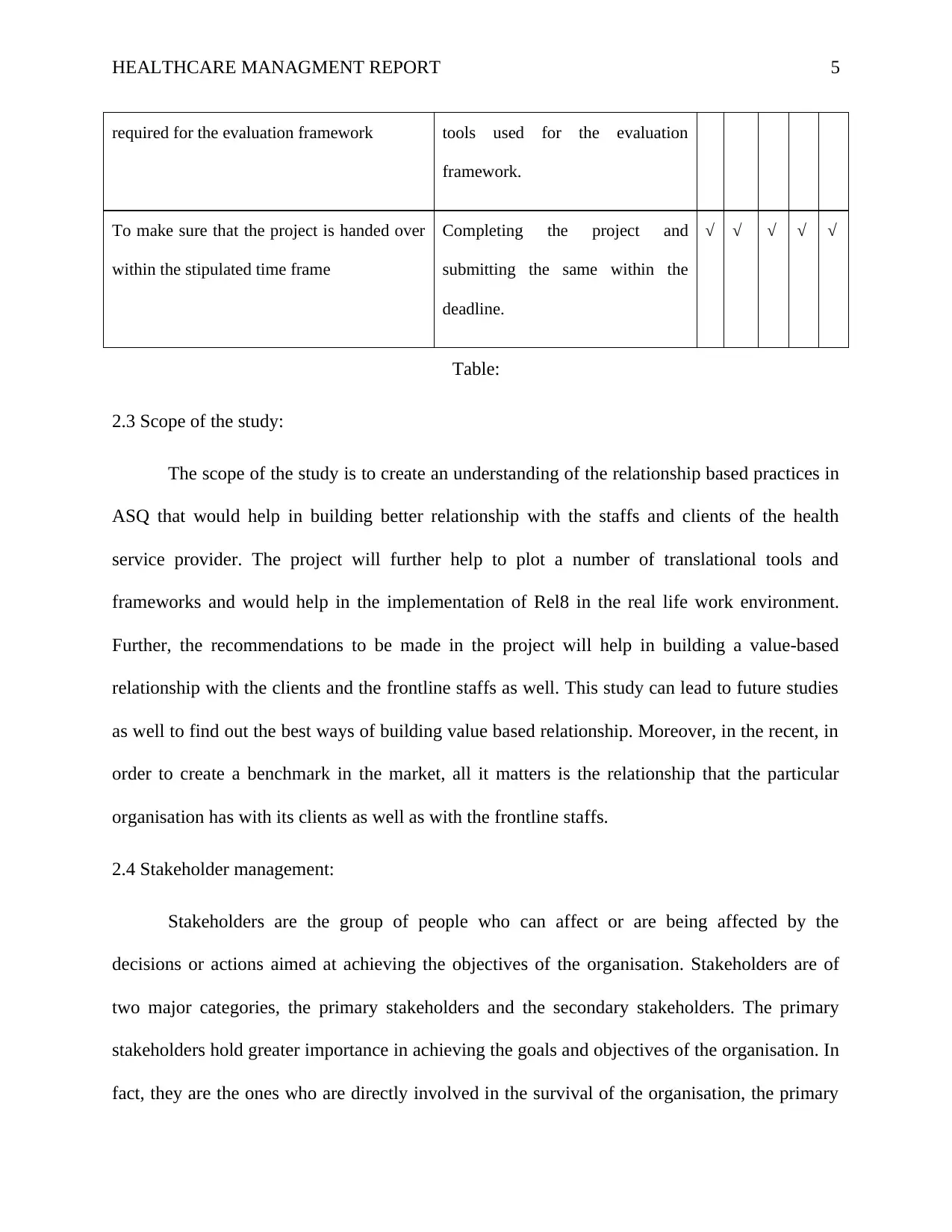
HEALTHCARE MANAGMENT REPORT 5
required for the evaluation framework tools used for the evaluation
framework.
To make sure that the project is handed over
within the stipulated time frame
Completing the project and
submitting the same within the
deadline.
√ √ √ √ √
Table:
2.3 Scope of the study:
The scope of the study is to create an understanding of the relationship based practices in
ASQ that would help in building better relationship with the staffs and clients of the health
service provider. The project will further help to plot a number of translational tools and
frameworks and would help in the implementation of Rel8 in the real life work environment.
Further, the recommendations to be made in the project will help in building a value-based
relationship with the clients and the frontline staffs as well. This study can lead to future studies
as well to find out the best ways of building value based relationship. Moreover, in the recent, in
order to create a benchmark in the market, all it matters is the relationship that the particular
organisation has with its clients as well as with the frontline staffs.
2.4 Stakeholder management:
Stakeholders are the group of people who can affect or are being affected by the
decisions or actions aimed at achieving the objectives of the organisation. Stakeholders are of
two major categories, the primary stakeholders and the secondary stakeholders. The primary
stakeholders hold greater importance in achieving the goals and objectives of the organisation. In
fact, they are the ones who are directly involved in the survival of the organisation, the primary
required for the evaluation framework tools used for the evaluation
framework.
To make sure that the project is handed over
within the stipulated time frame
Completing the project and
submitting the same within the
deadline.
√ √ √ √ √
Table:
2.3 Scope of the study:
The scope of the study is to create an understanding of the relationship based practices in
ASQ that would help in building better relationship with the staffs and clients of the health
service provider. The project will further help to plot a number of translational tools and
frameworks and would help in the implementation of Rel8 in the real life work environment.
Further, the recommendations to be made in the project will help in building a value-based
relationship with the clients and the frontline staffs as well. This study can lead to future studies
as well to find out the best ways of building value based relationship. Moreover, in the recent, in
order to create a benchmark in the market, all it matters is the relationship that the particular
organisation has with its clients as well as with the frontline staffs.
2.4 Stakeholder management:
Stakeholders are the group of people who can affect or are being affected by the
decisions or actions aimed at achieving the objectives of the organisation. Stakeholders are of
two major categories, the primary stakeholders and the secondary stakeholders. The primary
stakeholders hold greater importance in achieving the goals and objectives of the organisation. In
fact, they are the ones who are directly involved in the survival of the organisation, the primary
⊘ This is a preview!⊘
Do you want full access?
Subscribe today to unlock all pages.

Trusted by 1+ million students worldwide
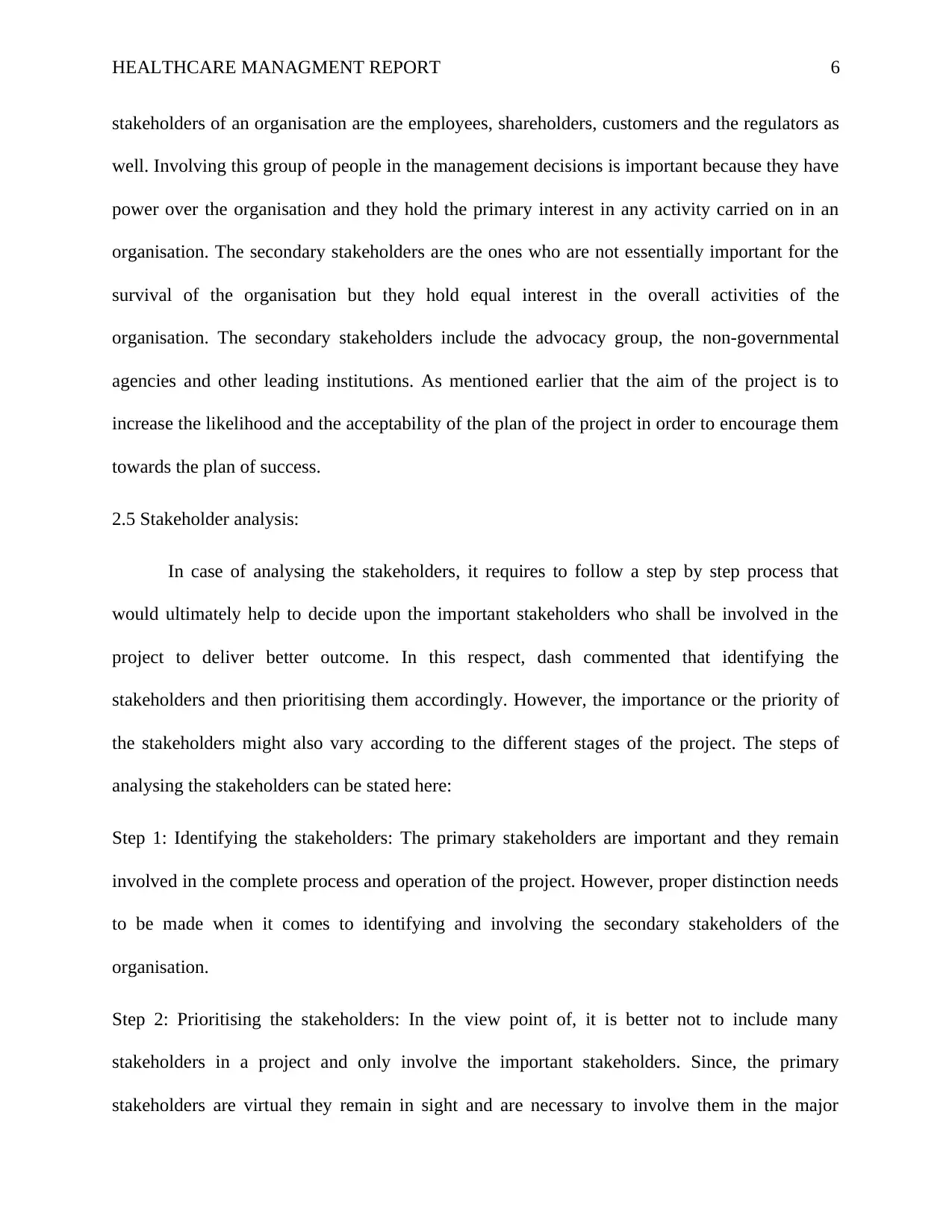
HEALTHCARE MANAGMENT REPORT 6
stakeholders of an organisation are the employees, shareholders, customers and the regulators as
well. Involving this group of people in the management decisions is important because they have
power over the organisation and they hold the primary interest in any activity carried on in an
organisation. The secondary stakeholders are the ones who are not essentially important for the
survival of the organisation but they hold equal interest in the overall activities of the
organisation. The secondary stakeholders include the advocacy group, the non-governmental
agencies and other leading institutions. As mentioned earlier that the aim of the project is to
increase the likelihood and the acceptability of the plan of the project in order to encourage them
towards the plan of success.
2.5 Stakeholder analysis:
In case of analysing the stakeholders, it requires to follow a step by step process that
would ultimately help to decide upon the important stakeholders who shall be involved in the
project to deliver better outcome. In this respect, dash commented that identifying the
stakeholders and then prioritising them accordingly. However, the importance or the priority of
the stakeholders might also vary according to the different stages of the project. The steps of
analysing the stakeholders can be stated here:
Step 1: Identifying the stakeholders: The primary stakeholders are important and they remain
involved in the complete process and operation of the project. However, proper distinction needs
to be made when it comes to identifying and involving the secondary stakeholders of the
organisation.
Step 2: Prioritising the stakeholders: In the view point of, it is better not to include many
stakeholders in a project and only involve the important stakeholders. Since, the primary
stakeholders are virtual they remain in sight and are necessary to involve them in the major
stakeholders of an organisation are the employees, shareholders, customers and the regulators as
well. Involving this group of people in the management decisions is important because they have
power over the organisation and they hold the primary interest in any activity carried on in an
organisation. The secondary stakeholders are the ones who are not essentially important for the
survival of the organisation but they hold equal interest in the overall activities of the
organisation. The secondary stakeholders include the advocacy group, the non-governmental
agencies and other leading institutions. As mentioned earlier that the aim of the project is to
increase the likelihood and the acceptability of the plan of the project in order to encourage them
towards the plan of success.
2.5 Stakeholder analysis:
In case of analysing the stakeholders, it requires to follow a step by step process that
would ultimately help to decide upon the important stakeholders who shall be involved in the
project to deliver better outcome. In this respect, dash commented that identifying the
stakeholders and then prioritising them accordingly. However, the importance or the priority of
the stakeholders might also vary according to the different stages of the project. The steps of
analysing the stakeholders can be stated here:
Step 1: Identifying the stakeholders: The primary stakeholders are important and they remain
involved in the complete process and operation of the project. However, proper distinction needs
to be made when it comes to identifying and involving the secondary stakeholders of the
organisation.
Step 2: Prioritising the stakeholders: In the view point of, it is better not to include many
stakeholders in a project and only involve the important stakeholders. Since, the primary
stakeholders are virtual they remain in sight and are necessary to involve them in the major
Paraphrase This Document
Need a fresh take? Get an instant paraphrase of this document with our AI Paraphraser
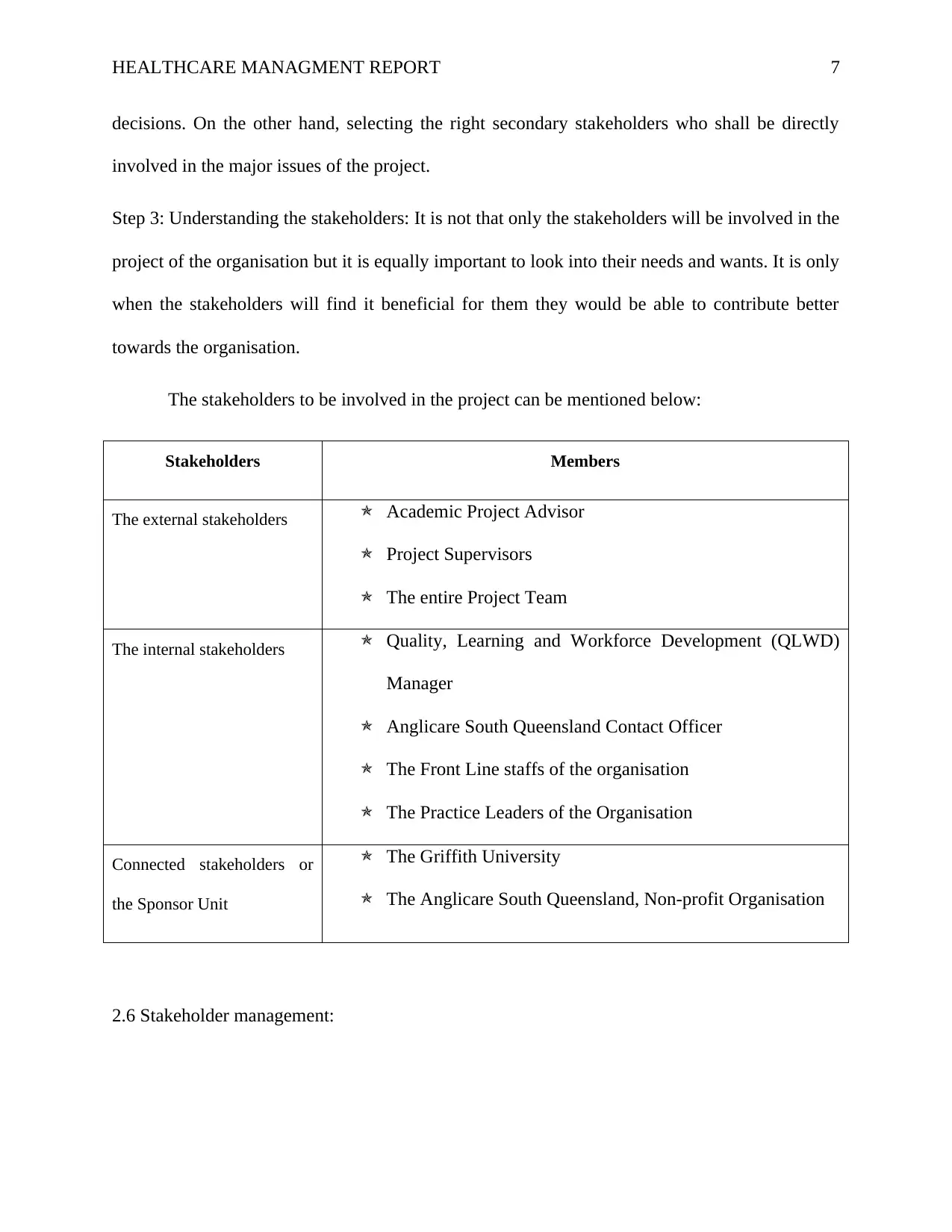
HEALTHCARE MANAGMENT REPORT 7
decisions. On the other hand, selecting the right secondary stakeholders who shall be directly
involved in the major issues of the project.
Step 3: Understanding the stakeholders: It is not that only the stakeholders will be involved in the
project of the organisation but it is equally important to look into their needs and wants. It is only
when the stakeholders will find it beneficial for them they would be able to contribute better
towards the organisation.
The stakeholders to be involved in the project can be mentioned below:
Stakeholders Members
The external stakeholders Academic Project Advisor
Project Supervisors
The entire Project Team
The internal stakeholders Quality, Learning and Workforce Development (QLWD)
Manager
Anglicare South Queensland Contact Officer
The Front Line staffs of the organisation
The Practice Leaders of the Organisation
Connected stakeholders or
the Sponsor Unit
The Griffith University
The Anglicare South Queensland, Non-profit Organisation
2.6 Stakeholder management:
decisions. On the other hand, selecting the right secondary stakeholders who shall be directly
involved in the major issues of the project.
Step 3: Understanding the stakeholders: It is not that only the stakeholders will be involved in the
project of the organisation but it is equally important to look into their needs and wants. It is only
when the stakeholders will find it beneficial for them they would be able to contribute better
towards the organisation.
The stakeholders to be involved in the project can be mentioned below:
Stakeholders Members
The external stakeholders Academic Project Advisor
Project Supervisors
The entire Project Team
The internal stakeholders Quality, Learning and Workforce Development (QLWD)
Manager
Anglicare South Queensland Contact Officer
The Front Line staffs of the organisation
The Practice Leaders of the Organisation
Connected stakeholders or
the Sponsor Unit
The Griffith University
The Anglicare South Queensland, Non-profit Organisation
2.6 Stakeholder management:
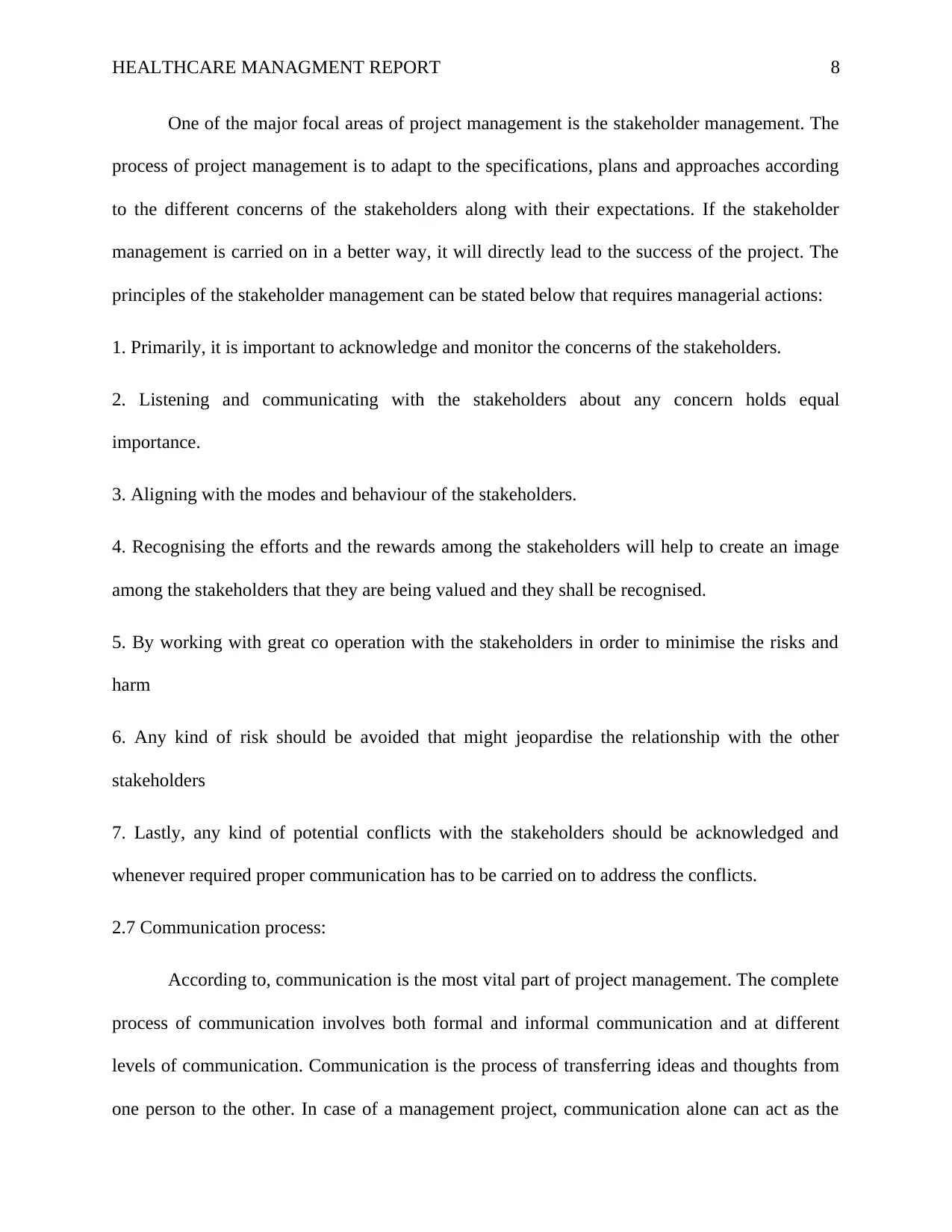
HEALTHCARE MANAGMENT REPORT 8
One of the major focal areas of project management is the stakeholder management. The
process of project management is to adapt to the specifications, plans and approaches according
to the different concerns of the stakeholders along with their expectations. If the stakeholder
management is carried on in a better way, it will directly lead to the success of the project. The
principles of the stakeholder management can be stated below that requires managerial actions:
1. Primarily, it is important to acknowledge and monitor the concerns of the stakeholders.
2. Listening and communicating with the stakeholders about any concern holds equal
importance.
3. Aligning with the modes and behaviour of the stakeholders.
4. Recognising the efforts and the rewards among the stakeholders will help to create an image
among the stakeholders that they are being valued and they shall be recognised.
5. By working with great co operation with the stakeholders in order to minimise the risks and
harm
6. Any kind of risk should be avoided that might jeopardise the relationship with the other
stakeholders
7. Lastly, any kind of potential conflicts with the stakeholders should be acknowledged and
whenever required proper communication has to be carried on to address the conflicts.
2.7 Communication process:
According to, communication is the most vital part of project management. The complete
process of communication involves both formal and informal communication and at different
levels of communication. Communication is the process of transferring ideas and thoughts from
one person to the other. In case of a management project, communication alone can act as the
One of the major focal areas of project management is the stakeholder management. The
process of project management is to adapt to the specifications, plans and approaches according
to the different concerns of the stakeholders along with their expectations. If the stakeholder
management is carried on in a better way, it will directly lead to the success of the project. The
principles of the stakeholder management can be stated below that requires managerial actions:
1. Primarily, it is important to acknowledge and monitor the concerns of the stakeholders.
2. Listening and communicating with the stakeholders about any concern holds equal
importance.
3. Aligning with the modes and behaviour of the stakeholders.
4. Recognising the efforts and the rewards among the stakeholders will help to create an image
among the stakeholders that they are being valued and they shall be recognised.
5. By working with great co operation with the stakeholders in order to minimise the risks and
harm
6. Any kind of risk should be avoided that might jeopardise the relationship with the other
stakeholders
7. Lastly, any kind of potential conflicts with the stakeholders should be acknowledged and
whenever required proper communication has to be carried on to address the conflicts.
2.7 Communication process:
According to, communication is the most vital part of project management. The complete
process of communication involves both formal and informal communication and at different
levels of communication. Communication is the process of transferring ideas and thoughts from
one person to the other. In case of a management project, communication alone can act as the
⊘ This is a preview!⊘
Do you want full access?
Subscribe today to unlock all pages.

Trusted by 1+ million students worldwide
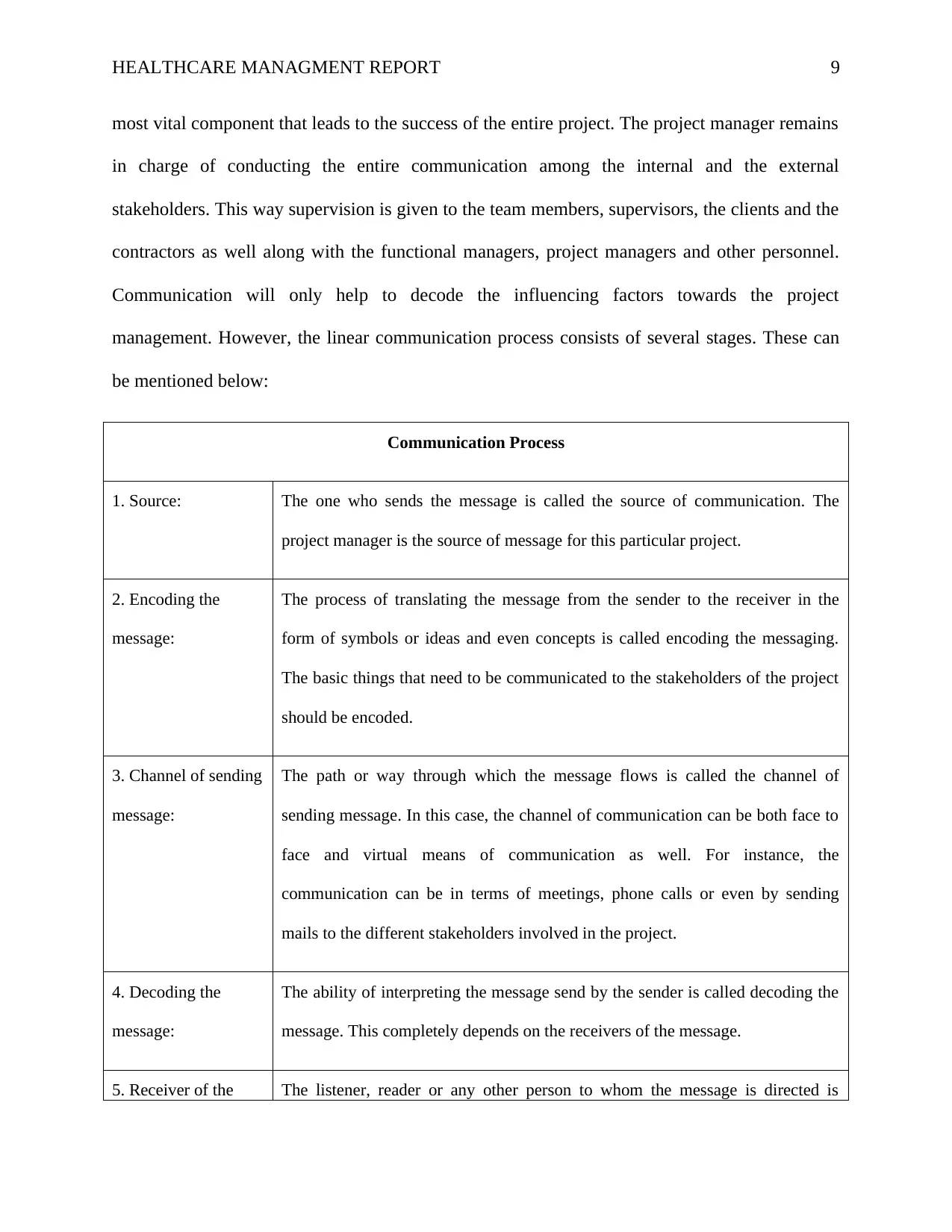
HEALTHCARE MANAGMENT REPORT 9
most vital component that leads to the success of the entire project. The project manager remains
in charge of conducting the entire communication among the internal and the external
stakeholders. This way supervision is given to the team members, supervisors, the clients and the
contractors as well along with the functional managers, project managers and other personnel.
Communication will only help to decode the influencing factors towards the project
management. However, the linear communication process consists of several stages. These can
be mentioned below:
Communication Process
1. Source: The one who sends the message is called the source of communication. The
project manager is the source of message for this particular project.
2. Encoding the
message:
The process of translating the message from the sender to the receiver in the
form of symbols or ideas and even concepts is called encoding the messaging.
The basic things that need to be communicated to the stakeholders of the project
should be encoded.
3. Channel of sending
message:
The path or way through which the message flows is called the channel of
sending message. In this case, the channel of communication can be both face to
face and virtual means of communication as well. For instance, the
communication can be in terms of meetings, phone calls or even by sending
mails to the different stakeholders involved in the project.
4. Decoding the
message:
The ability of interpreting the message send by the sender is called decoding the
message. This completely depends on the receivers of the message.
5. Receiver of the The listener, reader or any other person to whom the message is directed is
most vital component that leads to the success of the entire project. The project manager remains
in charge of conducting the entire communication among the internal and the external
stakeholders. This way supervision is given to the team members, supervisors, the clients and the
contractors as well along with the functional managers, project managers and other personnel.
Communication will only help to decode the influencing factors towards the project
management. However, the linear communication process consists of several stages. These can
be mentioned below:
Communication Process
1. Source: The one who sends the message is called the source of communication. The
project manager is the source of message for this particular project.
2. Encoding the
message:
The process of translating the message from the sender to the receiver in the
form of symbols or ideas and even concepts is called encoding the messaging.
The basic things that need to be communicated to the stakeholders of the project
should be encoded.
3. Channel of sending
message:
The path or way through which the message flows is called the channel of
sending message. In this case, the channel of communication can be both face to
face and virtual means of communication as well. For instance, the
communication can be in terms of meetings, phone calls or even by sending
mails to the different stakeholders involved in the project.
4. Decoding the
message:
The ability of interpreting the message send by the sender is called decoding the
message. This completely depends on the receivers of the message.
5. Receiver of the The listener, reader or any other person to whom the message is directed is
Paraphrase This Document
Need a fresh take? Get an instant paraphrase of this document with our AI Paraphraser
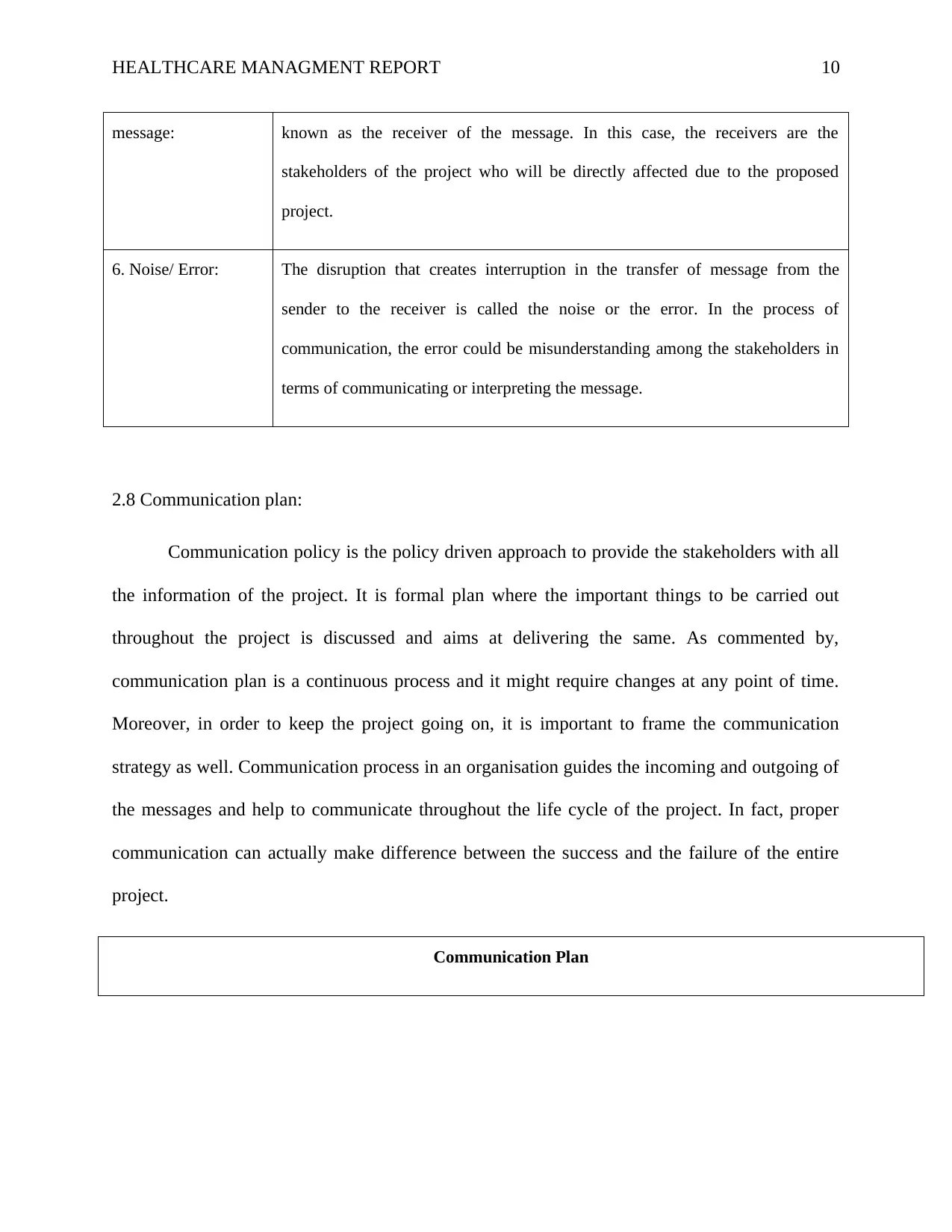
HEALTHCARE MANAGMENT REPORT 10
message: known as the receiver of the message. In this case, the receivers are the
stakeholders of the project who will be directly affected due to the proposed
project.
6. Noise/ Error: The disruption that creates interruption in the transfer of message from the
sender to the receiver is called the noise or the error. In the process of
communication, the error could be misunderstanding among the stakeholders in
terms of communicating or interpreting the message.
2.8 Communication plan:
Communication policy is the policy driven approach to provide the stakeholders with all
the information of the project. It is formal plan where the important things to be carried out
throughout the project is discussed and aims at delivering the same. As commented by,
communication plan is a continuous process and it might require changes at any point of time.
Moreover, in order to keep the project going on, it is important to frame the communication
strategy as well. Communication process in an organisation guides the incoming and outgoing of
the messages and help to communicate throughout the life cycle of the project. In fact, proper
communication can actually make difference between the success and the failure of the entire
project.
Communication Plan
message: known as the receiver of the message. In this case, the receivers are the
stakeholders of the project who will be directly affected due to the proposed
project.
6. Noise/ Error: The disruption that creates interruption in the transfer of message from the
sender to the receiver is called the noise or the error. In the process of
communication, the error could be misunderstanding among the stakeholders in
terms of communicating or interpreting the message.
2.8 Communication plan:
Communication policy is the policy driven approach to provide the stakeholders with all
the information of the project. It is formal plan where the important things to be carried out
throughout the project is discussed and aims at delivering the same. As commented by,
communication plan is a continuous process and it might require changes at any point of time.
Moreover, in order to keep the project going on, it is important to frame the communication
strategy as well. Communication process in an organisation guides the incoming and outgoing of
the messages and help to communicate throughout the life cycle of the project. In fact, proper
communication can actually make difference between the success and the failure of the entire
project.
Communication Plan
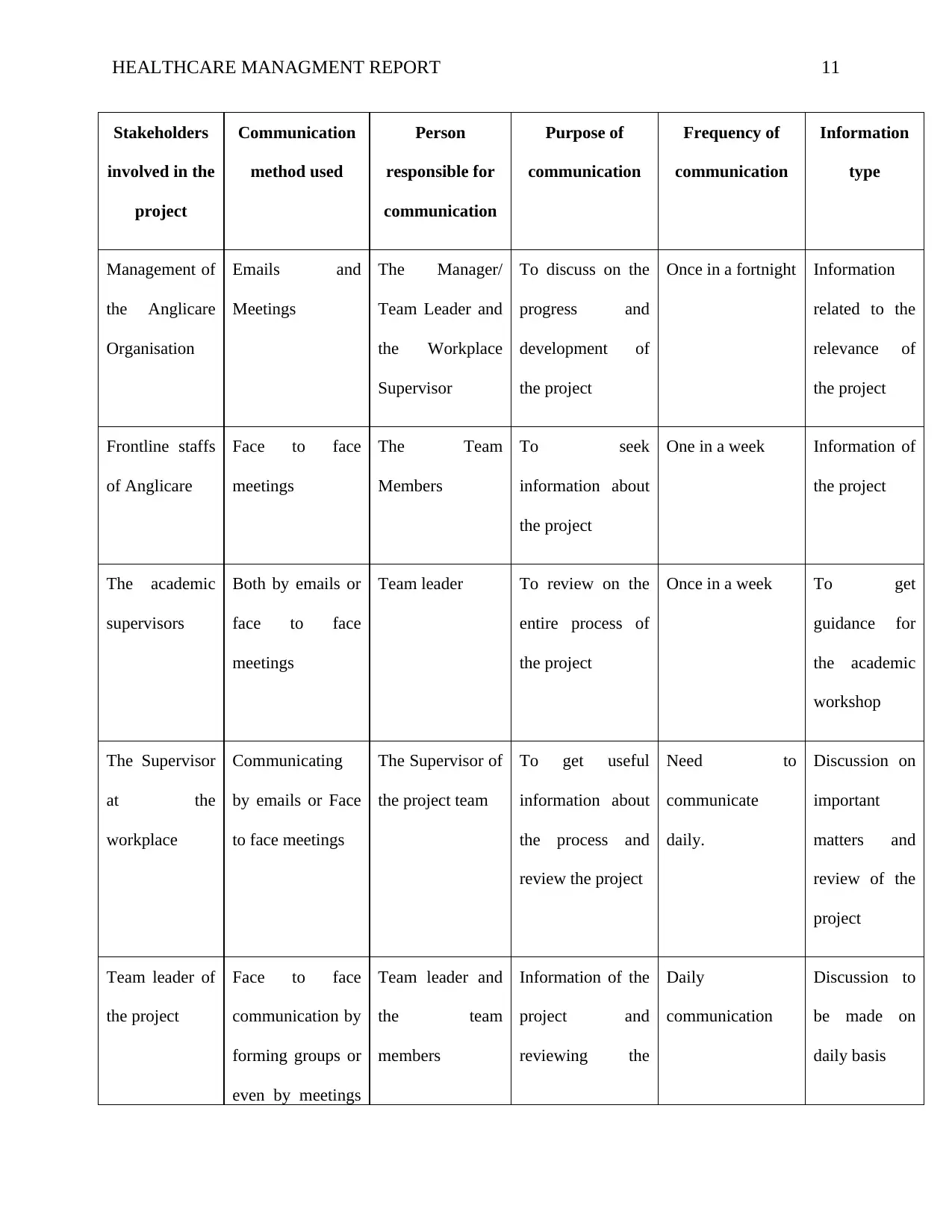
HEALTHCARE MANAGMENT REPORT 11
Stakeholders
involved in the
project
Communication
method used
Person
responsible for
communication
Purpose of
communication
Frequency of
communication
Information
type
Management of
the Anglicare
Organisation
Emails and
Meetings
The Manager/
Team Leader and
the Workplace
Supervisor
To discuss on the
progress and
development of
the project
Once in a fortnight Information
related to the
relevance of
the project
Frontline staffs
of Anglicare
Face to face
meetings
The Team
Members
To seek
information about
the project
One in a week Information of
the project
The academic
supervisors
Both by emails or
face to face
meetings
Team leader To review on the
entire process of
the project
Once in a week To get
guidance for
the academic
workshop
The Supervisor
at the
workplace
Communicating
by emails or Face
to face meetings
The Supervisor of
the project team
To get useful
information about
the process and
review the project
Need to
communicate
daily.
Discussion on
important
matters and
review of the
project
Team leader of
the project
Face to face
communication by
forming groups or
even by meetings
Team leader and
the team
members
Information of the
project and
reviewing the
Daily
communication
Discussion to
be made on
daily basis
Stakeholders
involved in the
project
Communication
method used
Person
responsible for
communication
Purpose of
communication
Frequency of
communication
Information
type
Management of
the Anglicare
Organisation
Emails and
Meetings
The Manager/
Team Leader and
the Workplace
Supervisor
To discuss on the
progress and
development of
the project
Once in a fortnight Information
related to the
relevance of
the project
Frontline staffs
of Anglicare
Face to face
meetings
The Team
Members
To seek
information about
the project
One in a week Information of
the project
The academic
supervisors
Both by emails or
face to face
meetings
Team leader To review on the
entire process of
the project
Once in a week To get
guidance for
the academic
workshop
The Supervisor
at the
workplace
Communicating
by emails or Face
to face meetings
The Supervisor of
the project team
To get useful
information about
the process and
review the project
Need to
communicate
daily.
Discussion on
important
matters and
review of the
project
Team leader of
the project
Face to face
communication by
forming groups or
even by meetings
Team leader and
the team
members
Information of the
project and
reviewing the
Daily
communication
Discussion to
be made on
daily basis
⊘ This is a preview!⊘
Do you want full access?
Subscribe today to unlock all pages.

Trusted by 1+ million students worldwide
1 out of 40
Related Documents
Your All-in-One AI-Powered Toolkit for Academic Success.
+13062052269
info@desklib.com
Available 24*7 on WhatsApp / Email
![[object Object]](/_next/static/media/star-bottom.7253800d.svg)
Unlock your academic potential
Copyright © 2020–2025 A2Z Services. All Rights Reserved. Developed and managed by ZUCOL.





